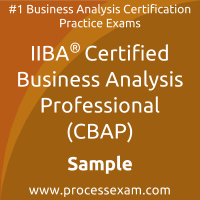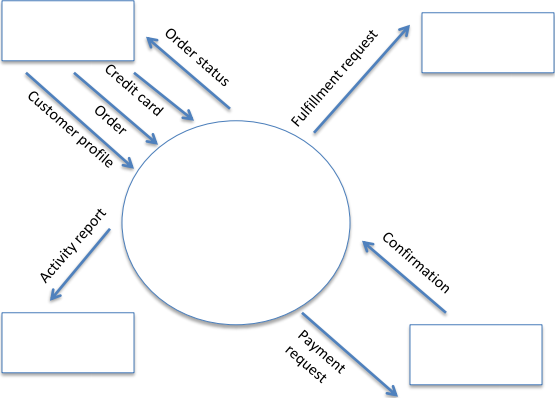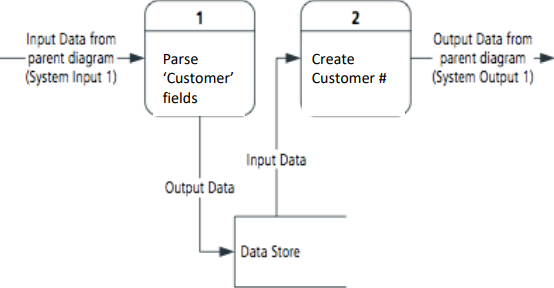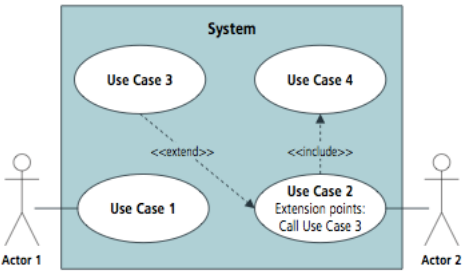 You have to pass the CBAP exam to receive the certification from IIBA. To increase the effectiveness of your study and make you familiar with the actual exam pattern, we have prepared this IIBA Business Analysis Professional sample questions. Our Sample IIBA Certified Business Analysis Professional Practice Exam will give you more insight about both the type and the difficulty level of the questions on the IIBA Business Analysis Professional exam.
You have to pass the CBAP exam to receive the certification from IIBA. To increase the effectiveness of your study and make you familiar with the actual exam pattern, we have prepared this IIBA Business Analysis Professional sample questions. Our Sample IIBA Certified Business Analysis Professional Practice Exam will give you more insight about both the type and the difficulty level of the questions on the IIBA Business Analysis Professional exam.
However, we are strongly recommending practice with our Premium IIBA Certified Business Analysis Professional (CBAP) Practice Exam to achieve the best score in your actual IIBA CBAP Exam. The premium practice exam questions are more comprehensive, exam oriented, scenario-based and exact match of IIBA Certified Business Analysis Professional exam questions.
IIBA Business Analysis Professional Sample Questions:
01. The business analyst (BA), developer, tester and subject matter expert are reviewing the current state in order to break down significant elements of the problem to solve. The BA starts to draw the following sketch (see below).
Based on the sketch, an observation the BA would make would be:
a) The process flow for entering an order is bi-directional
b) The systems interface for exchanging order details is unidirectional
c) The end-to-end test scenario is initiated by entering orders from a remote system
d) The use case for reporting order activity is an extension of the use case for entering an order
02. A business analyst (BA) is working to identify pain points on decentralized software maintenance and license contract management process. Four major stakeholders are involved in this process. The stakeholders are unclear about who is doing what and what is expected to be done.
What should the BA do to delineate the stakeholders’ roles?
a) Create a RACI Matrix
b) Monitor stakeholder engagement
c) Assign stakeholders specific tasks
d) Provide adequate time for group discussions
03. The developer asks the business analyst (BA) to clarify key concepts in the proposed design definition based on the initial draft diagram below. The next step for the BA is to:
a) Associate actors with use cases
b) Separate processes into swim lanes
c) Create foreign keys for entity relationships
d) Elaborate input and output for data transformations
04. In the following SWOT list, the quadrant market “ST” represents the intersection of:
a) Future strengths with current threats
b) Future threats with future strengths
c) Current strengths with future threats
d) Current strengths with current threats
05. A regulatory agency recently changed the record retention requirements for financial services providers. All financial reports must be retained in electronic format both on production reporting servers and in an off-site data repository.
What output will the business analyst need to manage the requirements impacted by this regulatory change?
a) Communication plans
b) Traceability repository
c) Solution scope
d) Performance objectives
06. The business analyst (BA) has brought key stakeholders together in a workshop to refine everyone’s understanding of a proposed application. The BA is correct in saying:
a) Use Case 4 expresses common behavior across several use cases
b) Use Case 1 occurs before Use Case 3
c) Use Case 2 adds unique behavior across several use cases
d) Use Case 3 occurs before Use Case 4
07. A business analyst (BA) is defining a business analysis approach that should be compatible with the other project activities. Assessing the new solution's limitations should be planned as well.
When should this activity be performed?
a) When the solution is designed
b) When the solution is fully implemented
c) When the elicitation activities are complete
d) When the solution is in use in some form
08. An organization maintains a central repository for managing new products that are brought into the organization. This central repository was built over a decade ago, initially starting in a spreadsheet, then moved to various iterations of a custom solution built in house.
There are many pitfalls in the current implementation and it does not have clear set of baseline requirements. The organization wants to improve the process. A business analyst (BA) is tasked to start the requirement elicitation.
Which of the following should the BA do?
a) Develop the performance measures for the new solution
b) Document the current solution's existing functionality
c) Create a wish list of desired performance functionality
d) Review the features of commercial off-the-shelf products
09. Which four dimensions does the Balanced Scorecard technique use to express business value?
Select the correct choice:
a) Learning and Growth, Business Process, Customer, and Financial
b) Learning and Growth, Business Process, Customer, and Strategy
c) Learning and Growth, Business Perspective, Customer, and Strategy
d) Learning and Growth, Business Perspective, Customer, and Financial
10. A business analyst (BA) meets with a long-tenured vice president who expresses disagreement with the objectives of the project on which the BA is currently engaged. In what way does the vice president impact the BA's next step?
a) The vice president's high level of influence will cause the BA to leverage the organizational modelling technique.
b) The vice president's decision making authority will cause the BA to develop a new stakeholder engagement approach.
c) The vice president's negative attitude towards the project will cause the BA to leverage the risks analysis and management technique.
d) The vice president's disagreement with the project's objectives will cause the BA to leverage the stakeholder list, map, or personas technique.
Answers:
Question: 01
Answer: c |
Question: 02
Answer: a |
Question: 03
Answer: d |
Question: 04
Answer: c |
Question: 05
Answer: b |
Question: 06
Answer: a |
Question: 07
Answer: d |
Question: 08
Answer: b |
Question: 09
Answer: a |
Question: 10
Answer: c |
If you find any errors or typos in IIBA Certified Business Analysis Professional (CBAP) sample question-answers or online IIBA Business Analysis Professional practice exam, please report them to us on feedback@processexam.com
 You have to pass the CBAP exam to receive the certification from IIBA. To increase the effectiveness of your study and make you familiar with the actual exam pattern, we have prepared this IIBA Business Analysis Professional sample questions. Our Sample IIBA Certified Business Analysis Professional Practice Exam will give you more insight about both the type and the difficulty level of the questions on the IIBA Business Analysis Professional exam.
You have to pass the CBAP exam to receive the certification from IIBA. To increase the effectiveness of your study and make you familiar with the actual exam pattern, we have prepared this IIBA Business Analysis Professional sample questions. Our Sample IIBA Certified Business Analysis Professional Practice Exam will give you more insight about both the type and the difficulty level of the questions on the IIBA Business Analysis Professional exam.


